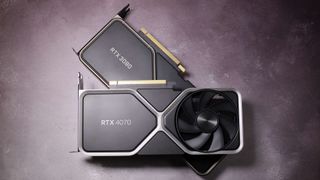Intel and Samsung plan to join foundry forces to combat TSMC says a major Korean newspaper
It's unlikely that we'll see an Intel-designed, Samsung-made CPU in a gaming PC any time soon, though.

When it comes to manufacturing high-end processors and other chips, one company dominates the market and that's TSMC. The second largest producer, Samsung, is well behind and Intel makes the merest of impressions in the sector. So it's perhaps not a surprise to learn that a daily newspaper in Korea has said that the latter two are planning to meet up and create a 'foundry alliance' to make headway in the chip market.
The publication in question is Maeil Business Newspaper (locally just known as MK) and its report about Intel reaching out to Samsung to arrange a meeting to discuss a foundry team-up (via Trendforce) does have some weight to it, as both companies have been struggling of late.
Intel's foundry service has been losing substantial amounts of money and plans to expand its chip-making facilities outside of the US have been impacted by cost-cutting measures introduced due to the general downturn in the company's finances. As things currently stand, Intel makes its own chips and has a number of other contracts, but otherwise, its order books are fairly empty.
It's a better state of affairs over at Samsung. The tech giant manufactures RAM and NAND flash memory chips, as well as processors for its own phones, but it has hundreds of customers for its foundry services. However, it's well short of the thousands that TSMC has and Trendforce notes that the latter has roughly 62% of the foundry market share compared to a mere 11% for Samsung.
But while it's in a distant second place, Samsung makes far more chips than Intel does, so it raises a very obvious question: How would it benefit from being in a chip-making alliance with Intel?
Team Blue has two key pieces of technology it can bring to the discussion table: Foveros and PowerVia. The former is used in its Meteor and Arrow Lake processors to mount all of the various tiles into a single package and it's been crucial for Intel to combat AMD and its chiplet technologies.
PowerVia is a production process that helps significantly reduce power consumption and heat generation. It was originally planned to be introduced with Arrow Lake until Intel switched to employing TSMC to make all the tiles.
The biggest gaming news, reviews and hardware deals
Keep up to date with the most important stories and the best deals, as picked by the PC Gamer team.

Best CPU for gaming: The top chips from Intel and AMD.
Best gaming motherboard: The right boards.
Best graphics card: Your perfect pixel-pusher awaits.
Best SSD for gaming: Get into the game ahead of the rest.
Both companies also have production and packaging facilities around the world, and at a time when the US and EU are tightening restrictions on exporting chips to certain countries, having a wide local presence makes it easier to combat those limitations.
Should an alliance come to pass, I don't think the average PC gamer will see any benefit, unfortunately. Other than RAM and SSDs, the last major PC component to be made exclusively by Samsung was the GPU in Nvidia's RTX 30-series graphics cards and that company looks certain to stick with TSMC for the foreseeable future, as will AMD. Intel may well employ Samsung to manufacture certain tiles for Ultra Core processors but when that could happen is anyone's guess.
One thing is certain, though, and it's that Intel and Samsung are going to try everything possible to try and beat TSMC at its own game. After all, there are billions of dollars of potential revenue on the line, especially in the AI market, and when big money is up for grabs, market rivalries don't mean anything.

Nick, gaming, and computers all first met in 1981, with the love affair starting on a Sinclair ZX81 in kit form and a book on ZX Basic. He ended up becoming a physics and IT teacher, but by the late 1990s decided it was time to cut his teeth writing for a long defunct UK tech site. He went on to do the same at Madonion, helping to write the help files for 3DMark and PCMark. After a short stint working at Beyond3D.com, Nick joined Futuremark (MadOnion rebranded) full-time, as editor-in-chief for its gaming and hardware section, YouGamers. After the site shutdown, he became an engineering and computing lecturer for many years, but missed the writing bug. Cue four years at TechSpot.com and over 100 long articles on anything and everything. He freely admits to being far too obsessed with GPUs and open world grindy RPGs, but who isn't these days?

AMD's 2025 laptop plans sure do include a lot of refreshed and rebranded APUs, but who cares when you've got Fire Range, Strix Halo, and four RDNA 4 mobile GPUs heading our way next year

Intel admits the Arrow Lake launch missed the mark and promises performance fixes by December, but my testing suggests you shouldn't get your hopes up
Most Popular






